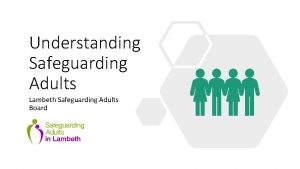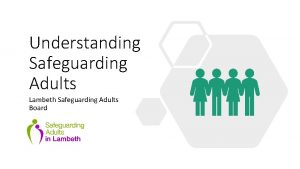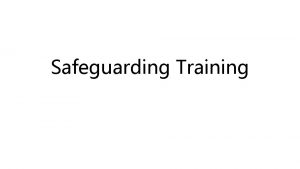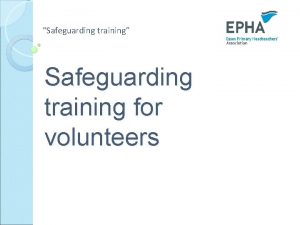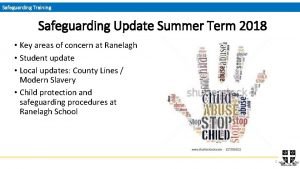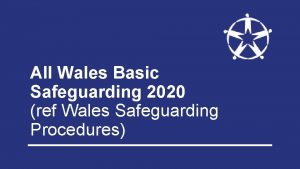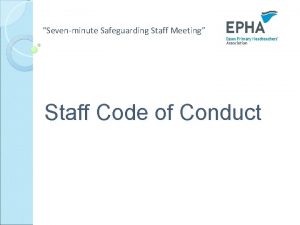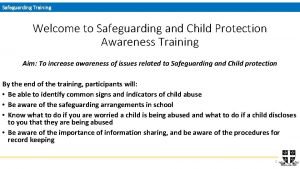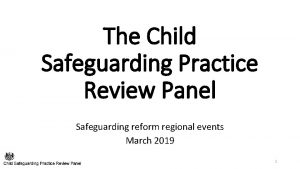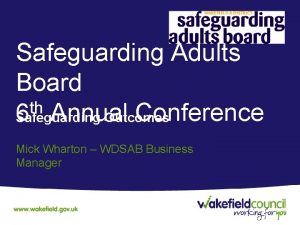Safeguarding Update for all staff th 30 January































- Slides: 31

Safeguarding Update for all staff th 30 January 2017

Question 1 What is the overarching safeguarding document for everyone working with children and young people?


Question 2 Safeguarding and promoting the welfare of children is defined as which four aspects?

Protection from maltreatment Preventing impairment of health or development Grow up with provision of safe and effective care Action taken for all children to have the best outcomes

Question 3 Who has the responsibility to ensure that the learning environment is safe?

Everybody

Question 4 Why is it important to 'think the unthinkable'


Question 5 Who can contact Social Care services if they are concerned?

Anybody

© 2016 Andrew Hall | safeguarding. pro Question 6 In Serious Case Reviews, which six factors often lead to safeguarding failures?

Failure to act soon enough Poor record-keeping Failure to listen to the child Failure to re-assess Sharing too slowly Lack of challenge to inaction

Question 7 What is the difference between Safeguarding and Child Protection?

Safeguarding is for everyone.

Question 8 What are the four types of abuse and neglect?

Sexual Neglect Physical Emotional

What do you (already) know about Safeguarding Children? Statements 1 All child abusers come from deprived backgrounds and have a below average I. Q. 2 Girls are more likely to be sexually abused than boys. 3 All physical injuries observed on a child, such as bruises, are a cause for concern and should result in a Child Protection referral being made. 4 Children are more likely to be abused by someone that they or their family don’t already know (e. g. a stranger). Children often make things up (e. g. that they have been abused) so we must take what they say with a ‘pinch of salt’. ‘Emotional Abuse’ is about telling your children off when they have been naughty. Very young children (i. e. under 1 year old) are particularly vulnerable to abuse. Domestic Violence mainly poses a risk to children because they might get injured if they are caught up in fights between adults. Parents who have mental health problems are more likely to abuse their children. If you are worried that a child may be a victim of abuse it is your job to investigate and prove or disprove it. Once a child has been abused they are more likely to be re-victimised. If you have concerns about a colleague’s conduct it’s ok to have a quiet word with them and say no more about it. 5 6 7 8 9 10 11 12 True False

The 4 categories of abuse • • Emotional (E) Sexual (S) Neglect (N) Physical (P)

Put in their category of abuse


Learning Lessons Daniel Pelka Review - Retrospective Deeper Analysis and Progress Report on Implementation of Recommendations (23 rd Jan 2014) Recording Keeping & Assessment of Risk “the concerns about Daniel were not effectively communicated across the staff team and there was no formal mechanism for gathering information together across the school. ” “Assessments within the school failed to bring together all known information and identify risk of abuse. This was because recording systems within the school were used inconsistently and did not bring together all information into a central place in order to enable an accurate assessment of need and risk. It is important to emphasise the recording arrangements in place at your school including the use of body maps to record observed injuries. “

Dealing with disclosure Case Study – Rachel is a pupil in your year nine at school. Her attendance has always been excellent and she has performed well in school. Shortly after the Christmas break you notice that Rachel's demeanour has changed. She has become very quiet and withdrawn in class and her grades are getting worse. She often fails to hand in homework and her attendance is deteriorating. Other teachers at the school have also spoken to you regarding their concerns about the negative changes they have seen in Rachel. You have overheard some of the other girls from your class talking about Rachel and saying that she was having 'boy troubles'. You decide to ask Rachel if there is anything wrong. Rachel tells you that since she started seeing one of the year nine boys over Christmas some of the other girls in her year are not happy that they are together and have started to send her abusive messages on her mobile phone. Rachel also tells you that someone has posted lies about her on her Facebook profile saying that she has been caught shoplifting and that she was pregnant and has had an abortion. Rachel tells you that she has been worried that telling anyone about what was happening would get the girls involved into trouble and make the bullying worse.

What are the facts, observations, opinions and what is information from others? Where will you record the facts/your observations? What do you do next?

You decide to speak to the Matt regarding the bullying that Rachel is being subjected to. Matt decides to raise a s/g concern with DSL. The DSL reviews and agrees. The DSL contacts Police Officer linked with your school about what is happening to Rachel. The Police Officer advises to tell Rachel not to destroy any of the text messages or emails etc. as these could be used in evidence if necessary. DSL speaks to Rachel and ask her not to destroy any of the evidence of the bullying. Rachel’s mother comes into school for a meeting. The DSL and Matt also speak to the other students involved in the bullying. They acknowledge what has been happening. On the advice of the Police Officer you decide to follow a restorative justice approach. A meeting is organised involving Rachel and her mother, along with the students who were bullying Rachel and their parents. Following the meeting the bullying stops. The owner of the website is also contacted and asked to remove the lies that the bullies had posted on the site. This they agree to.

Case Study – Hardeep is 15 years old. In your lesson, Hardeep appears withdrawn and upset. At the end of a lesson you ask her to stay behind. You ask her if she is ok. Hardeep becomes teary and says she wants to tell you something but only if you promise to keep it confidential. Hardeep says that someone that she met at a local sports club is pressuring her to have sex with him. Hardeep is extremely upset and tells you she is scared. Hardeep says that the person pressuring her is her brother’s 21 year old friend, Ben. Their families have been friends for ten years and Ben’s mum works with Hardeep’s dad. A few months ago, they smoked some weed in Ben’s garden and Hardeep says she got off with Ben and they did stuff to each other. Ben says he will tell her brother that she smoked weed and tell her friends she is a slag if she doesn’t have sex with him. Hardeep tells you she is frightened that her brother will tell her parents so she has decided to have sex with Ben this weekend. Hardeep says that she has told you everything. She’s really ashamed about having done stuff and about what her family will say. Hardeep repeats that she wants you to promise not to tell.

What would you tell Hardeep and what would you do next? 1. Explain to Hardeep that you still need to share as you have a duty to safeguard and promote her welfare; 2. Tell Hardeep who you will tell and what will happen next; 3. Complete disclosure form for passing it to your Designated Safeguarding Lead (DSL); Having listened, what information would you record? Try to include as much as possible of what was said by Hardeep. It is important to use her words, not yours e. g. ‘weed’, ‘got off with’ ‘did stuff’. Note also her non-verbal behaviour – tears, hesitation, and fear.

Safeguarding Leadership (interim) arrangements The s/g team: TB; SW; PON; LA As SLT, TB is Lead SW is Deputy (Wed-Fri) PON is Deputy (Mon-Fri) Communicating a concern Speak with any member of s/g team Speak with year leader Speak with Matt Email: z_concern


“ It could happen here”

Safeguarding in the Curriculum Across Years 7 -13, how are the following topic examples covered: cyberbullying, British culture, World cultures, sexual Health, British values, immigration, homosexuality, homophobia, healthy relationships, globalisation, free speech, internet safety, drugs/alcohol education, the economy, the rule of law, government, multi-culturalism, human rights, the media, work-related learning, etc. What’s required? * Subjects to arrive at examples
 Deferred update and immediate update
Deferred update and immediate update Name a point that is collinear with the given points
Name a point that is collinear with the given points Tack för att ni har lyssnat
Tack för att ni har lyssnat Shivaismen
Shivaismen Lågenergihus nyproduktion
Lågenergihus nyproduktion Inköpsprocessen steg för steg
Inköpsprocessen steg för steg Tidbok för yrkesförare
Tidbok för yrkesförare Rutin för avvikelsehantering
Rutin för avvikelsehantering Hur stor skarns är det för ett barn att få cancer
Hur stor skarns är det för ett barn att få cancer Presentera för publik crossboss
Presentera för publik crossboss Strategi för svensk viltförvaltning
Strategi för svensk viltförvaltning Iso 22301 utbildning
Iso 22301 utbildning Tack för att ni har lyssnat
Tack för att ni har lyssnat Boverket ka
Boverket ka Hur ser ett referat ut
Hur ser ett referat ut Läkarutlåtande för livränta
Läkarutlåtande för livränta Luftstrupen för medicinare
Luftstrupen för medicinare Tack för att ni lyssnade
Tack för att ni lyssnade Varför kallas perioden 1918-1939 för mellankrigstiden
Varför kallas perioden 1918-1939 för mellankrigstiden Kraft per area
Kraft per area Egg för emanuel
Egg för emanuel Borra hål för knoppar
Borra hål för knoppar Mitos steg
Mitos steg Smärtskolan kunskap för livet
Smärtskolan kunskap för livet Myndigheten för delaktighet
Myndigheten för delaktighet Mat för idrottare
Mat för idrottare Rbk-mätning
Rbk-mätning Anatomi organ reproduksi
Anatomi organ reproduksi Novell typiska drag
Novell typiska drag Argument för teckenspråk som minoritetsspråk
Argument för teckenspråk som minoritetsspråk Var 1721 för stormaktssverige
Var 1721 för stormaktssverige För och nackdelar med firo
För och nackdelar med firo

































